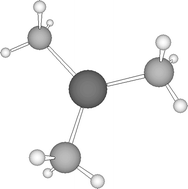The coordination chemistry of copper(i) in liquid ammonia, trialkyl and triphenyl phosphite, and tri-n-butylphosphine solution†
Abstract
The coordination chemistry of the solvate complexes of the relatively soft electron-pair acceptor copper(I) has been studied in solution and solid state in seven solvents with strong electron-pair donor properties, liquid ammonia, trimethyl, triethyl, triisopropyl, tri-n-butyl and triphenyl phosphite, and tri-n-butylphosphine. The solvate complexes have been characterised by means of EXAFS and 63Cu NMR spectroscopy, and in some cases also by 65Cu NMR spectroscopy. The copper(I) ion is three-coordinated, most probably in a coplanar trigonal fashion, in liquid ammonia with a mean Cu–N bond distance of 2.00(1) Å. No 63Cu NMR signal has been detected from the ammonia solvated copper(I) ion in liquid ammonia, which supports a three-coordination. The phosphite and phosphine solvated copper(I) ions are tetrahedral with Cu–P bond distances in the range 2.24–2.28 Å in both solution and solid state as determined by EXAFS spectroscopy. The tetrahedral configuration of these complexes has been confirmed by 63Cu and 65Cu NMR spectroscopy through the J(63Cu–31P) and J(65Cu–31P) couplings. The fact that two of the investigated complexes, [Cu(P(OC6H5)3)4]+ and [Cu(P(C4H9)3)4]+, are 63Cu and 65Cu NMR silent is probably caused by a significantly angular distorted tetrahedral configuration.


 Please wait while we load your content...
Please wait while we load your content...